- You are here:
- Home »
- Training With a Ball
Category Archives for Training With a Ball
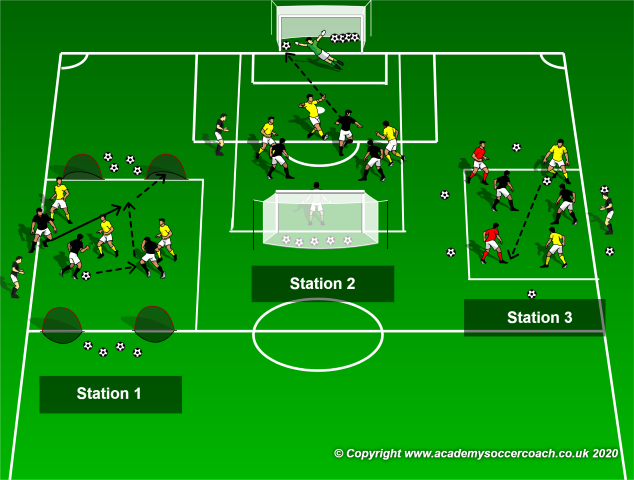
Aerobic Circuit With a Ball
By Philip Cauchi
Title: Soccer specific aerobic circuit.
Theme: Maintain the quality of soccer actions.
Development of the soccer domains:
Technical-tactical: Concepts of triangles, distances and angles, space creating and quick ball circulation.
Mental: Attitude towards winning the ball immediately upon losing it.
Socio-psychological: Communication (verbal and visual) and collaboration.
Physical: Maintain the quality of soccer actions high even after a prolonged period of time.
Organisation: Three stations are to be organised as shown in the diagram. Station 1 is a game of 3v3 on four mini goals. The area for this station is 30 yards by 20 yards. Station 2 is a 3+GKv3+GK on two regular goalposts. The goalkeepers always remain in this station. The dimensions for the area are 30 yards by 20 yards. Station 3 is a 2v2+2 transitional rondo. The dimensions for the area are 10 yards by 8 yards. A large number of balls should be positioned around the stations so to allow a high flow of the training session.
Description: In station 1 each team defends two mini goals positioned on the same line and attacks the opposite two. In station 2 a normal game is played where each team attacks one goal and defends the opposite. No corner kicks or throw-ins are in effect. If the ball goes out of play, restart takes place from the goalkeeper of the team in possession. In the 2v2+2 transitional rondo in station 3, two teams aim to keep the ball against the third team. Upon losing possession, the two attacking teams apply immediate pressure on the ball as the defending team can only change roles with the attacking team losing the ball if they succeed in dribbling the ball out of the area.
Training load: Play for two minutes at each station, rest for one minute and then move to the next station. Players rest for two minutes between circuits. The circuit should be repeated for four to six times depending on the fitness level of the players.
Periodization: This session should take place at least 72 hours following the previous match (MD+3) and at least 72 hours prior to the next one (MD-3).
Targeted energy system: Aerobic energy system, moving into a higher concentration of blood lactate at the latter part of the session.
Training considerations: The players who have not taken part or played a sufficient part in the previous match can still train at this intensity the day after the match.

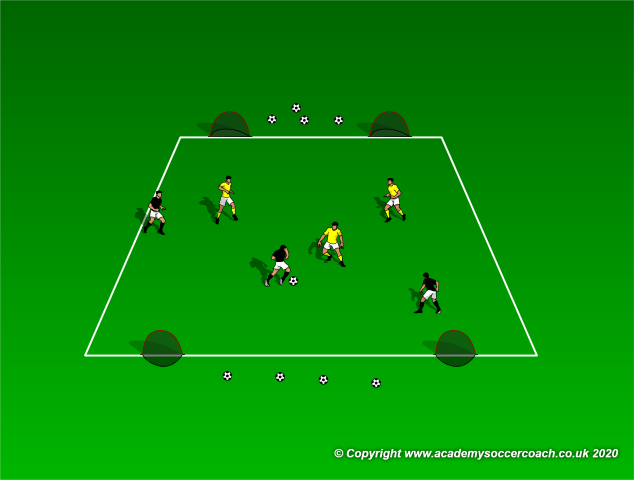
Station 1: 3v3 on four mini goals
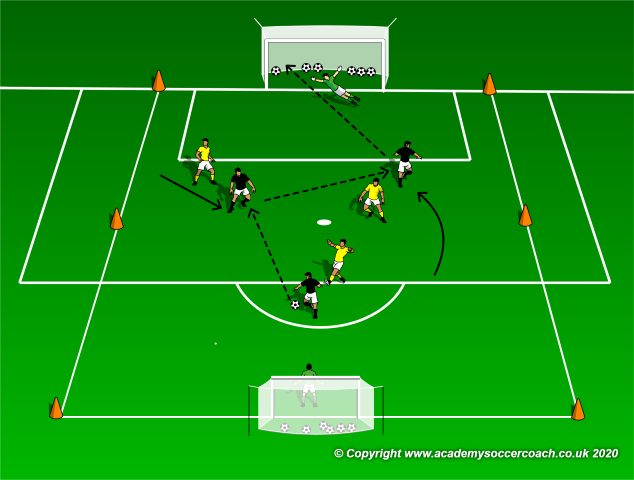
Station 2: 3v3 shooting game.
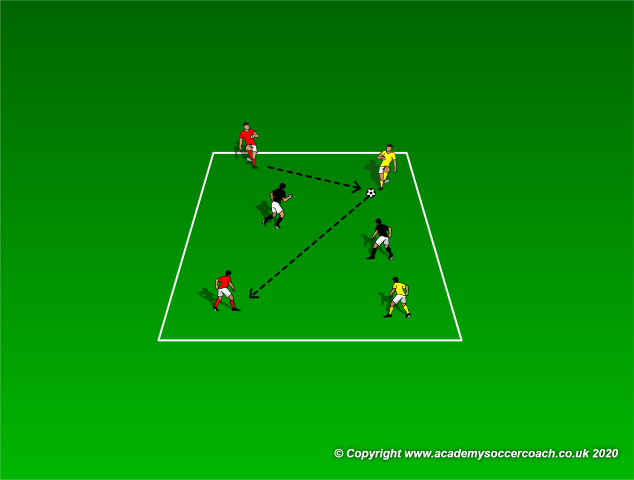
Station 3: 2v2+2 transitional rondo.
By Philip Cauchi

Conditioning With Quick Transition Game
By Philip Cauchi
Title: Quick transitions.
Theme: High intensity intermittent.
Development of the soccer domains:
Technical: Passing, dribbling, running with the ball and shooting.
Tactical: Attacking in a numerical superiority and defending in a numerical advantage.
Socio-psychological: Concentration, composure, quick decision-making, communication and collaboration.
Physical: Quick recovery between soccer actions.
Organisation: The practice area should measure 40 yards in length by 30 yards in width which is divided into two equal horizontal zones. The regular goalposts are positioned at both ends of the practice area. A goalkeeper is positioned in each of the two goals. We have two teams positioned at opposite ends. The yellow team is further divided into three subgroups while the black team is divided into two subgroups. One of the players of both teams has a ball at his feet.
Description: The two attackers (blacks) start either by passing the ball or dribble forward against the single defender. After the attack is over, teams switch roles and two players for the yellow team come into play, one of them with a ball. Now the yellows attack the blacks in a 3v2 with a numerical advantage in their favour. Scoring can only occur from inside the attacking half of the practice area. The offside rule is in effect from inside the attacking half for both the 2v1 and the 3v2 situations. If the defenders win the ball a quick transition occurs with the aim of scoring. Teams change positions after each series. Furthermore, after each attack the players from each team change their position. In this case the yellow team players will move one position to their right.
Training load: This obviously depends on the conditioning level of the players at your availability. However in this article we will go with the example of having four series of three minutes each with a two minute active rest in between (4 x 3’ – 2’ rest).
Periodization: This practice should be carried out on the endurance day which should not be less than 72 hours following the previous match (MD+3) and at least 72 hours prior to the next one (MD-3). This applies to the players who have played for more than 60 minutes (depending on the intensity of the match) in the last match. The players who did not play or played just a small part, can perform this session even in the day following the match.
Targeted energy system: Anaerobic lactic (high intensity soccer actions with incomplete recoveries).
Training considerations: This practice should be carried out at the end of a training session as we are working on endurance. Furthermore, technical-tactical training should be done at the beginning as this requires the players to be fresh.
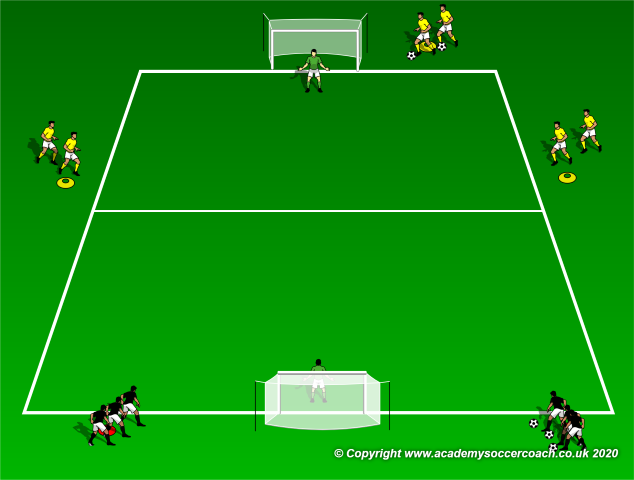
The setup of the exercise. The black team starts the attack.
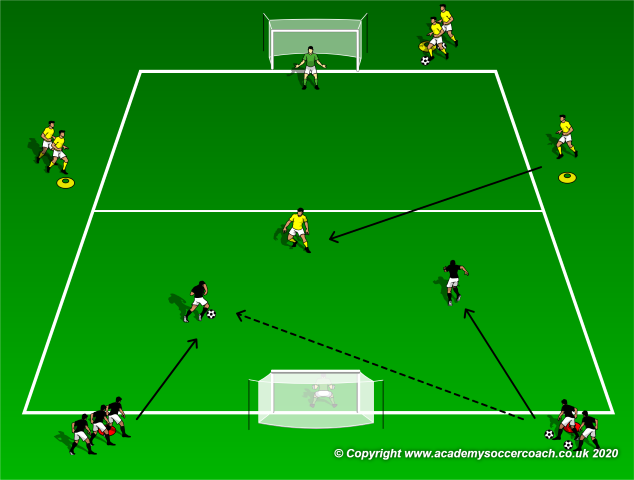
The black team starts in a 2v1 attack situation against the yellows.
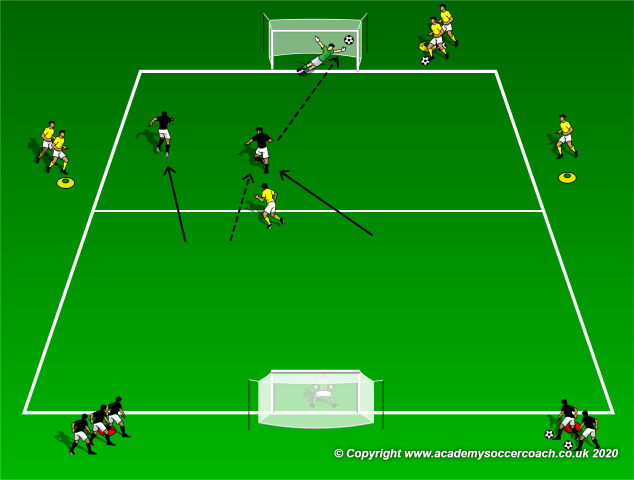
The attack is concluded from inside the black team’s attacking half.
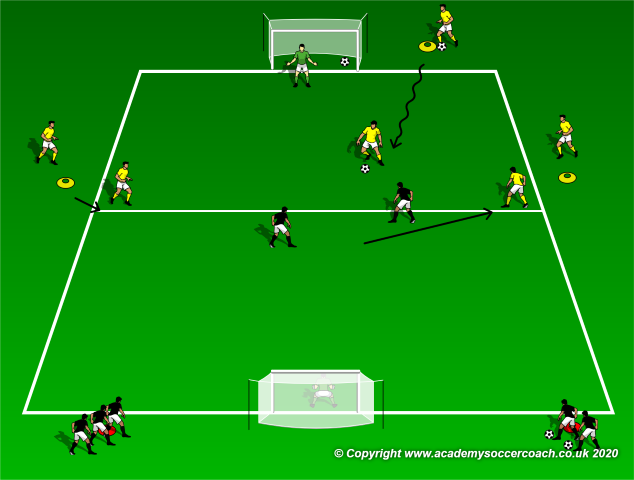
Immediately as the attack is over, the yellow team starts to attack in the opposite direction in a 3v2 situation.
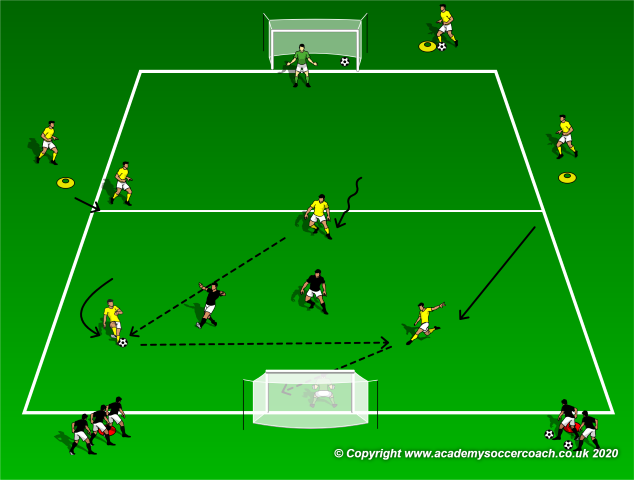
The yellow team concludes their attack. Therefore now a new attack involving different players from both teams take place.
Progression: Both teams have an allotted time to conclude at goal. The two blacks against the yellow have a maximum of eight seconds to score, while the yellows have a maximum of ten seconds against the blacks.
By Philip Cauchi
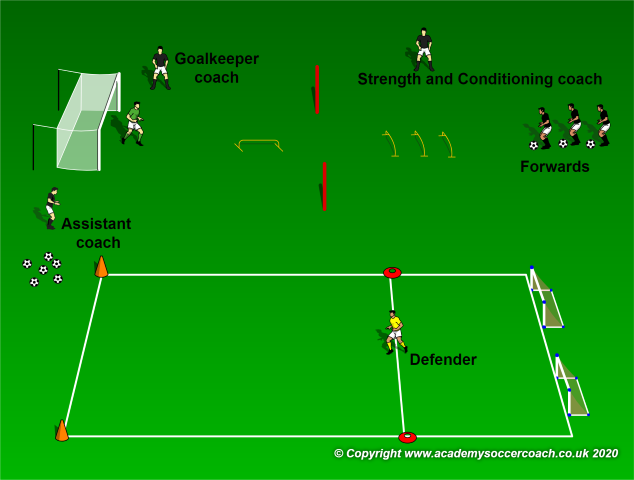
Attacking and Conditioning Drills
By Philip Cauchi
Title: Combined technique and strength endurance.
Theme: Applied strength.
Development of the soccer domains:
Technical: Attacking heading, aerial passing, dribbling, feints/fakes, and tackling.
Tactical: Defending 1v1.
Mental: Concentration, quick shift of focus (attacking in a 1v1 after heading the ball) and attitude to the positive or negative transition if the defender wins the ball in the 1v1.
Physical: Strength endurance for the lower body.
Organisation: The practice is specifically designed for forwards. We have a group of forwards in a line approximately 30 yards in front of the goal. Three hurdles (approximately 12 inches in height) are positioned in front of each other and a pole is positioned 8 yards to the both sides of the hurdles. Another hurdle is positioned 10 yards in front of the three hurdles. A goalkeeper is in goal, and we also have a pitch measuring 20 yards in length x 10 yards in width marked for the 1v1. Two mini goals are positioned on the goal line at one end while a gate is set for the counter attack (should the defender wins possession of the ball) at the opposite end.
Training load: 2 series of 6 repetitions each, with a rest of three minutes between series. The players should rest for one minute between repetitions. The work to rest ratio should be approximately from 1:4 to 1:5. The duration of each repetition should not be more than 20 seconds in total.
Periodization: This practice should be carried out on the strength day which should not be less than 72 hours following the previous match (MD+3) and at least 72 hours prior to the next one (MD-3). This applies for the players who have played for more than 60 minutes (depending on the intensity of the match) in the last match. The players who did not play or played just a small part, can perform this session even in the day following the match.
Targeted energy system: Anaerobic lactic (high speed of muscular contractions with incomplete recoveries).
Training considerations: The players should be thoroughly warmed up before this practice with special attention given to dynamic flexibility and mobility of the lower limbs.

The setup of the exercise. In the 1v1 exercise the defender must start on the marked line.
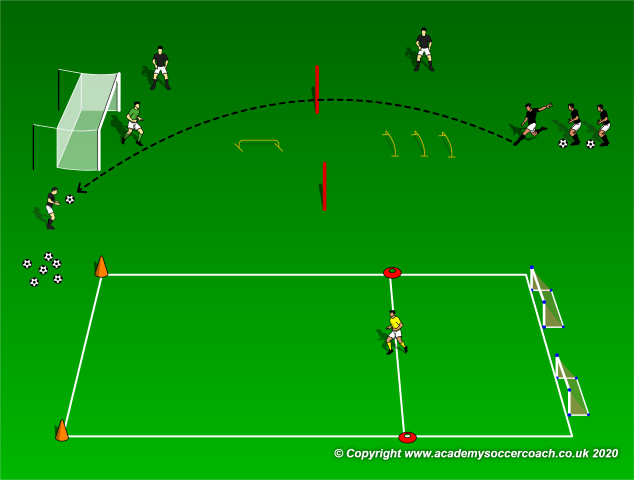
The forward plays a medium high pass to the assistant coach.
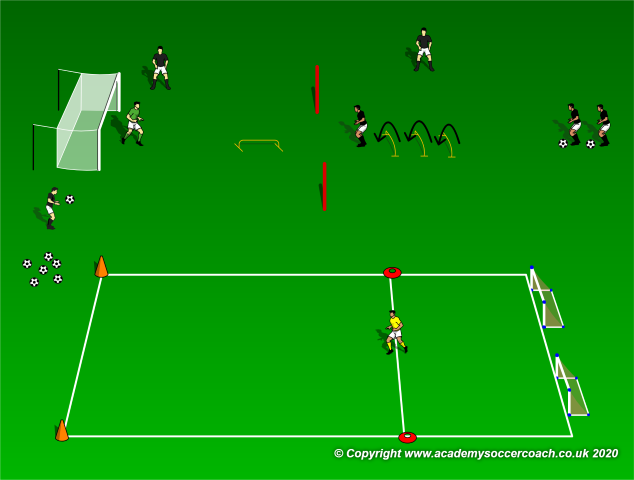
Following the pass, the forward performs three sequential high jumps over the hurdles.
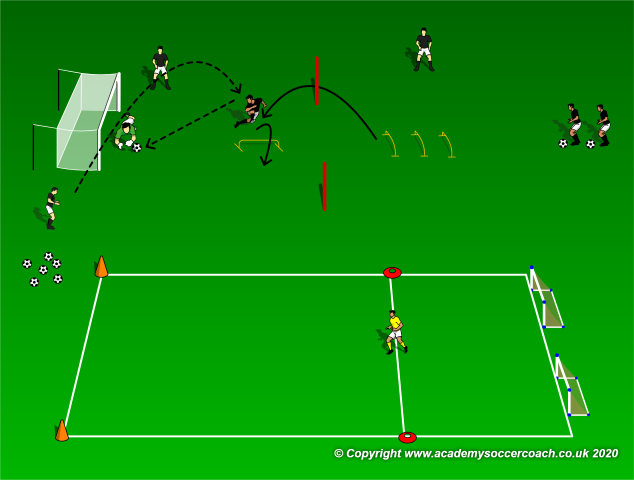
This is followed by running fast around the far pole and jumping over the hurdle (should be lower than the previous three hurdles) to finish the ball served by the coach with a header on goal. The coach serves from the right of the goal in the first series and then from the left in the second.
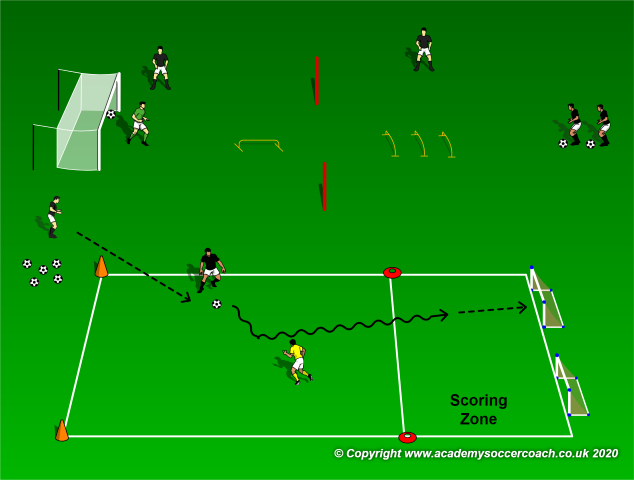
Immediately the forward receives the ball passed on the ground to play a 1v1 against the defender. The forward can only score from inside the marked scoring zone, while the defender scores (if he wins the ball) by dribbling between the two orange cones. The total duration of the exercise should not take more than 20 seconds, otherwise the exercise stops. Therefore, the offensive dribbling by the forward must be direct. When the attack is over the forward becomes a defender. After defending, the forward must again join the end of the line of forwards.
Variations:
1. Remove the 1v1.
2. Remove the single hurdle the forward jumps over to head the ball.
3. The pass from the forward to the assistant coach is played on the ground.
4. The forward concludes with a volley instead of a header.
Progressions:
1. Increase the number of sequential jumps
2. The forwards jump laterally.
By Philip Cauchi
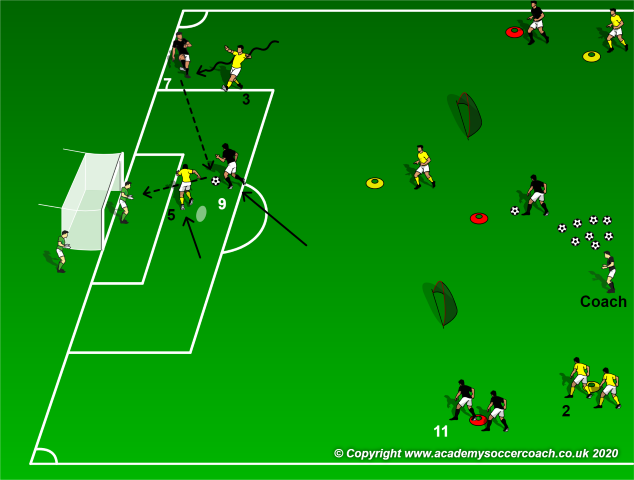
Conditioning With Attack v Defense
By Philip Cauchi
Title: Position specific explosiveness.
Theme: Applied power.
Development of the soccer domains:
Technical: Medium range passing, oriented first touch, dribbling forward at speed, tackling, crossing (including cut back passes) and finishing.
Tactical: Attacking down the flanks and getting unmarked inside the penalty area.
Mental: Quick decision-making of how to create space, get unmarked and when to attack the space created.
Physical: Explosive movements with changes of direction to attack the ball.
Organisation: The practice takes place in one half of the pitch. We have a goalkeeper in goal, a full back on both sides and a central defender. The attacking team has a striker and a winger on both sides. Two mini goals are positioned 15 yards in front of the penalty area. If the defenders win the ball, they counter on the two mini goals.
Training load: 2 series of 6 to 8 repetitions each. Rest for one minute between repetitions and for four minutes between series. We aim for a work to rest ratio of approximately 1:10.
Periodization: The exercise should be carried out on the speed and power day, not less than 48 hours prior to the match (MD-2).
Targeted energy system: Anaerobic alactic (high quality football actions with minimal accumulation of lactic acid).
Training considerations: The players should be thoroughly warmed up before this practice with specific attention given to dynamic flexibility of the lower limbs.
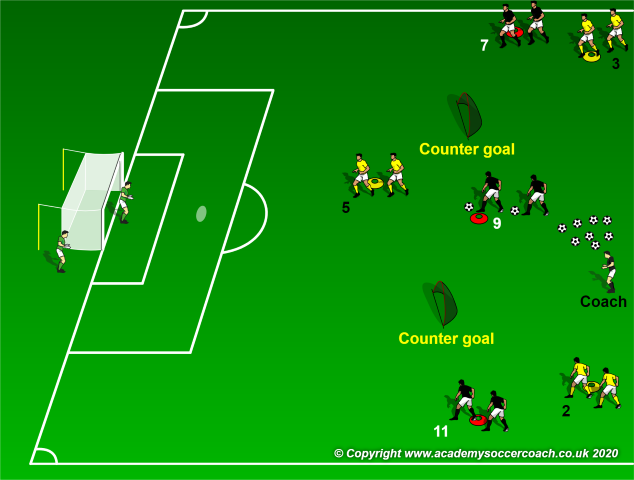
The play always starts from the striker’s position (black 9) who passes to either side (winger 7 or winger 11) depending on which winger has to go next.
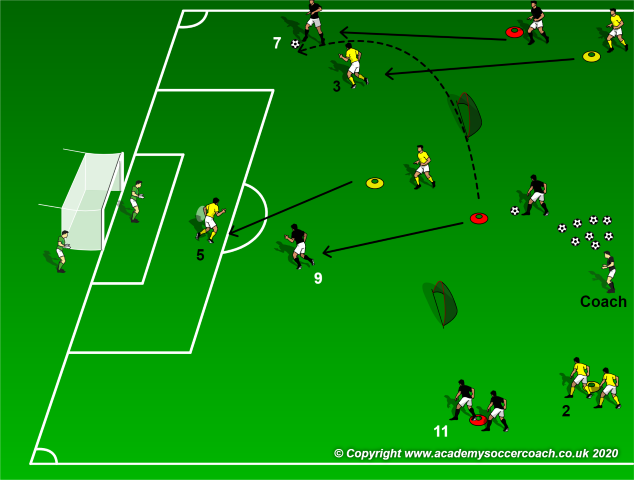
The striker (black 9) passes to the winger (black 7). At that moment the central defender (yellow 5) and the striker (black 9) move into the penalty area. The full back (yellow 3) trails behind the winger (black 7) who defends against the latter to prevent the cross.

The winger plays the cross for the striker to finish on target. Should the defender or the goalkeeper win the ball, the defending team quickly counters on the two mini goals.
Progressions:
1. The winger can opt to play the cross or dribble towards the inside.
2. When the ball is played on one flank, the opposite winger attacks while the opposite full back defends. Thus making the situation a 2v2 inside the penalty area. The winger on the ball can decide to either play the cross, a cut-back pass or dribble diagonally towards the centre.
By Philip Cauchi
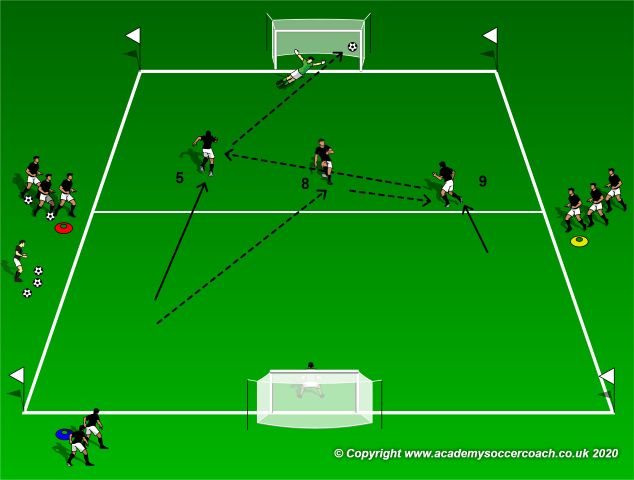
Conditioning Session Combined With Finishing
By Philip Cauchi
Theme: Intermittent training.
Development of the soccer domains:
Technical: Receiving, passing and shooting at goal.
Tactical: Mobility, length and depth in attack.
Mental: Move quickly to provide a passing option after playing the ball.
Physical: Keep performing the quality of football actions for a prolonged period of time by delaying the onset of fatigue.
Organization: Area measuring 40 yards in length x 20 yards in width. Three groups of players at positions 5, 8 and 9 and two goalkeepers in goal.
Training load: 6 blocks of 3 minutes with a 1 minute of rest in between blocks (work to rest ratio 3:1).
Periodization: The exercise should be carried out on the endurance day which is at least 72 hours prior to a match and not less than 72 hours following the previous one.
Targeted energy system: Aerobic lactic (perform a high number of football actions with minimal rest in between repetitions).
Training considerations: Consider the total load of the session and adjust the training load accordingly. This practice should be performed after tactical training as the players are required to be physically and mentally fresh for tactical practices. Thus, making sure that they will be focused on the tactical details.
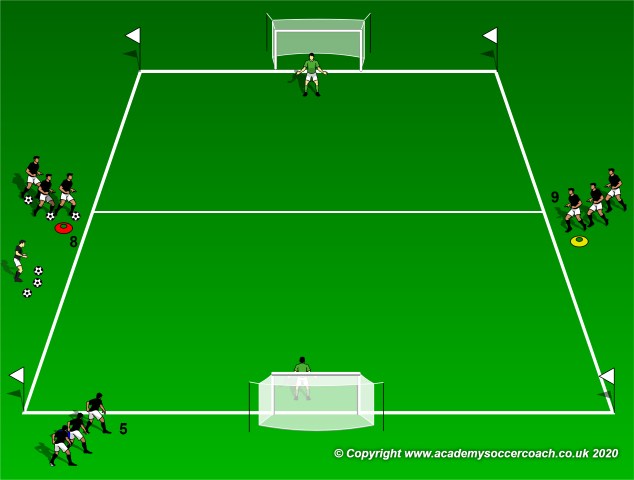
Player at position 8 starts with the ball. We can assimilate the positioning of the players to the positions they play in our system of play.
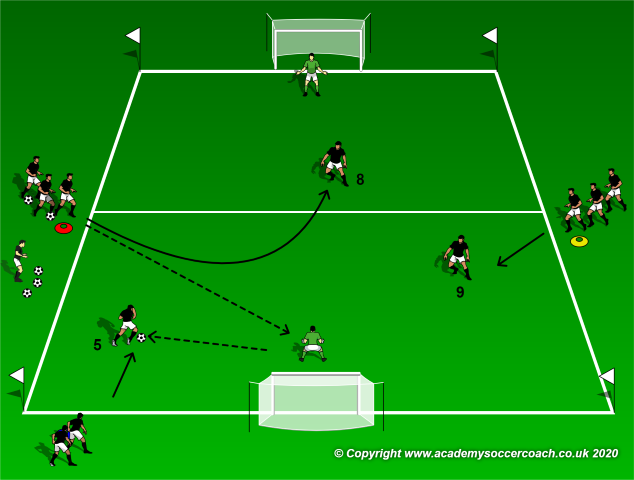
Player 8 passes the ball to the goalkeeper. Now, the three players must finish in the opposite goal in four or five passes maximum. The number of passes start being counted when the goalkeeper passes the first ball. The sequence of passes is for the players to decide. However, we give them these constraints. They must try to play with a maximum of two touch, they must move after passing the ball, they cannot be on the same vertical and horizontal lines and at the moment of shooting, they must all have crossed the midline.

Encourage off-the-ball movement and passing speed. Afterwards, the players move to a new position anticlockwise. When the round is over, the goalkeepers switch goalposts so that now the one who was involved in the build-up will be stopping shots and vice versa.
Progression:
Have four groups of players. When the ball is played back to the goalkeeper, the four players should form a diamond shape. The goalkeeper then decides to whom to play the ball. As constraints include that all four players should touch the ball at least once, they should move after passing, they cannot be in the same horizontal and vertical lines, and they must conclude in the opposite goal in under 15 seconds. As in the previous exercise, all the attacking players must be in the opposite half of the field when the shot is taken. When the round is over, the goalkeepers switch goalposts so that now the one who was involved in the build-up will be stopping shots and vice versa.
As a further progression the coach calls out to whom the goalkeeper should pass the first ball. As an example the coach may shout “number 9” and the goalkeeper plays a direct ball to the number 9.
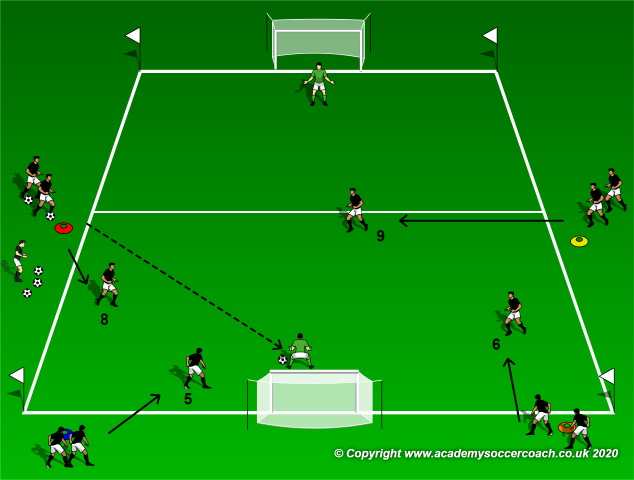
In this progression we have four groups. More options for the build-up and ball circulation exists.
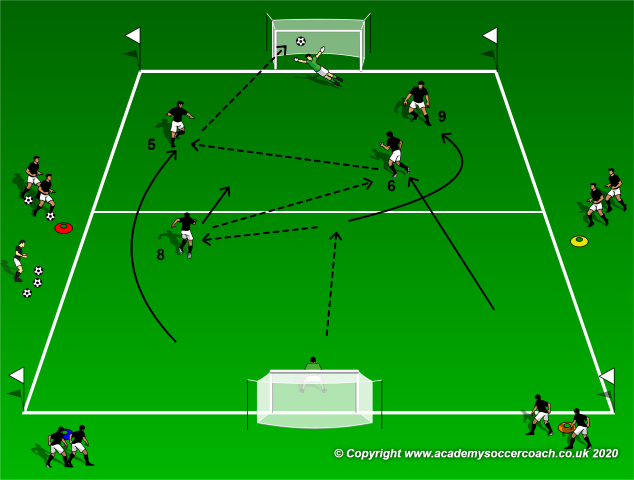
Encourage the players to perform off-the-ball movements after passing the ball such as overlaps and underlaps.
By Philip Cauchi
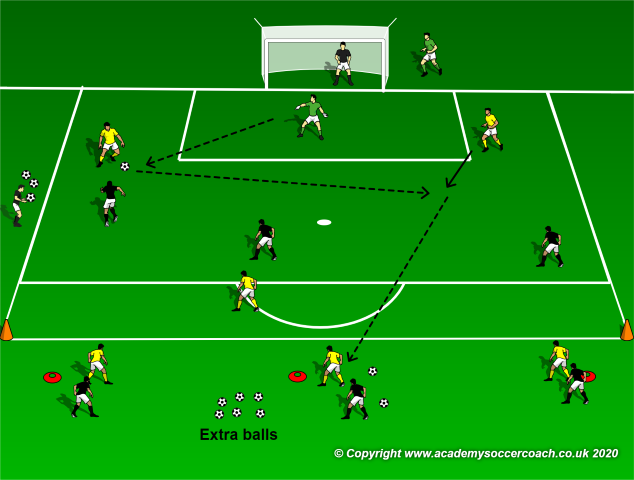
High Intensity Training 3v3+GK
By Philip Cauchi
Theme: Aerobic high intensity intermittent.
Development of the soccer domains:
Technical: Receiving, passing, dribbling, shooting, tackling, and blocking shots and goalkeeping.
Tactical: Defend aggressively inside the penalty area. Movement on and off-the-ball to create space to conclude at goal from inside the penalty area. Immediate transitions.
Mental: Anticipate quickly the movement of the opponent to be first on the ball. React quickly to moments of transitions.
Physical: Maintain a high intensity work rate while delaying the accumulation of fatigue.
Organisation: Area measuring 25 yards in length x 20 yards in width. A goalkeeper in goal with the goalkeeper coach behind him (if present) and another goalkeeper outside the goal ready to take her turn. Three defenders start inside the area. Groups of three players each outside the area as shown in the diagram hereunder. A number of balls should be available so if the ball goes out of playing bounds a new ball is put into play.
Training load: 2 blocks x 4 repetitions x 2 minutes each repetition interspersed with a recovery of one minute between repetitions and three minutes between blocks.
Total duration: approximately 30 minutes.
Periodization: The exercise should be carried out at least 72 hours prior to the next match (MD-3) and allow at least another 72 hours following the previous match.
Targeted energy system: Anaerobic lactic (delay the accumulation of lactate by having the body recover at a high rate between bouts of intense physical activity).
Training considerations: Ensure that the players are properly warmed up prior to commencing this activity. Group the players according to their position. For example the defence unit, the midfield unit and the forward unit.
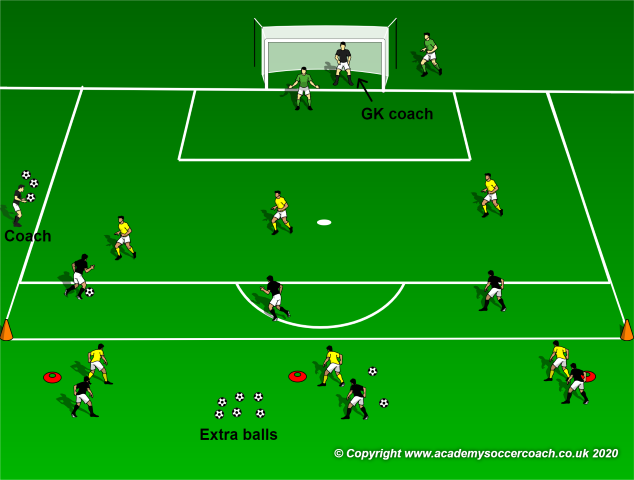
Three attackers start against three defenders plus a goalkeeper in goal. To allow the defenders time to recover, especially in moments of transition, the attackers may only score from inside the penalty area.
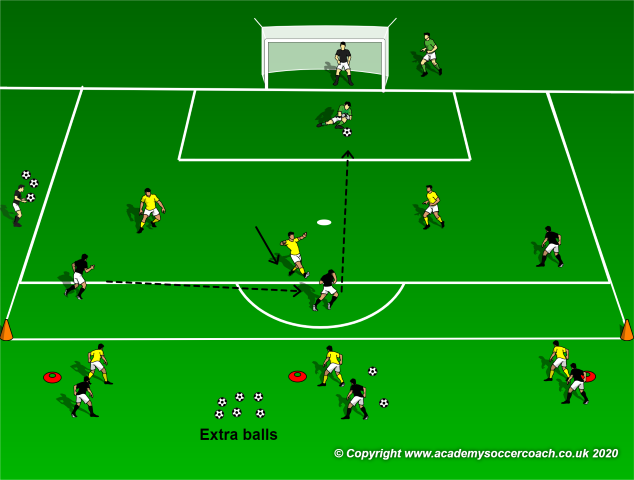
The actions are highly intensive and not only from a physical perspective but also from the mental.

If the goalkeeper makes the safe he can play it directly to the target players waiting outside the penalty area (yellows who are next in line to attack) or pass it to the defenders whose aim is to pass it to their teammates waiting to attack.
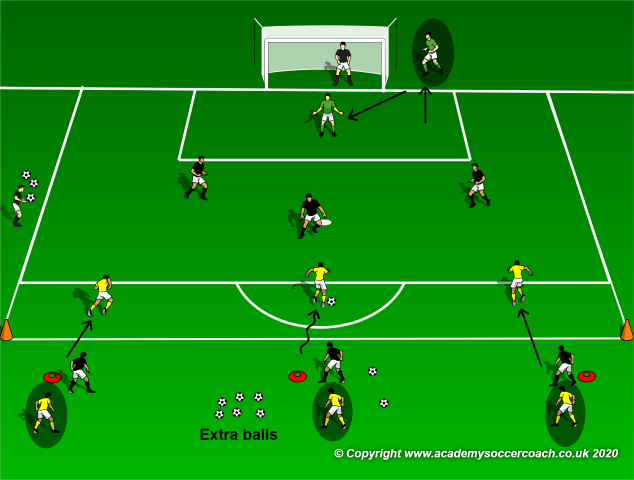
On transition, the previously attacking team (blacks) now defend while the previously defending team rests (circled). The goalkeepers switch after every attack or after a number of pre-established attacks.
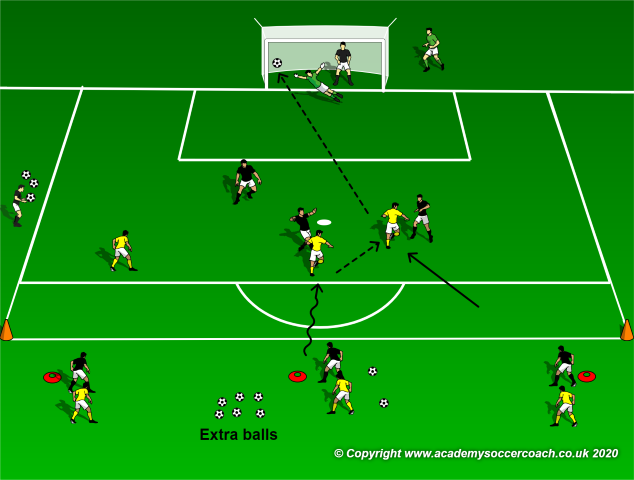
The attacking team (yellows) score. They have to transition immediately to defend. If their shot went wide, they would still transition to defend.
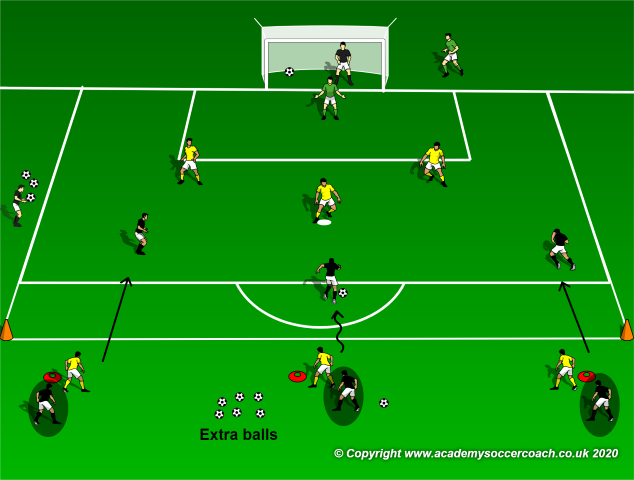
Now the previously attacking trio defend and the previously defending team rests (circled). A new team take their turn to attack.
Progression: To make it more challenging for a new attacking team, they must score after making three sequential passes following a transition (when the previously attacking team starts defending and a new team take their turn to attack). This gives the newly defending team more time to settle. However, afterwards the attacking team may score at any moment. This especially applies if the defending team wins the ball and the attacking team puts intensive pressure to regain possession. In this situation the attackers may score immediately if possession is regained. Thus the match realism of the practice is retained.
By Philip Cauchi
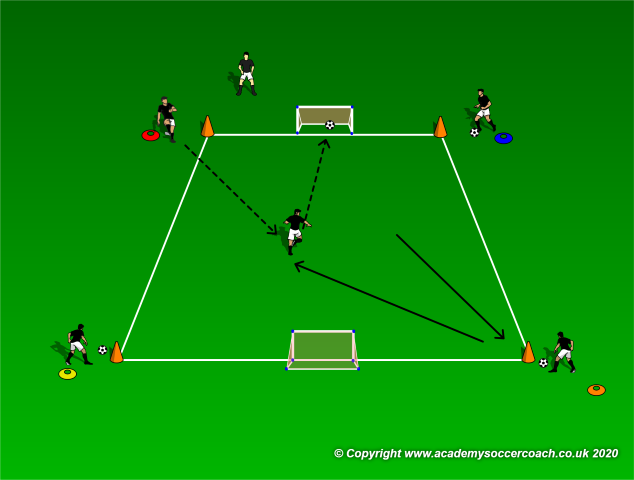
Four Corners Reactive Agility
By Philip Cauchi
Title: Four corners reactive agility.
Theme: Reactive agility.
Development of the soccer domains:
Technical: Receiving and passing the ball with accuracy.
Tactical: n/a.
Mental: React quickly to verbal and visual stimuli.
Physical: Perform quick changes of direction at speed while maintaining balance.
Organisation: Area measuring 5 yards x 5 yards. A player with a ball is positioned at each corner of the grid. Two mini goals are positioned facing each other. Corners are marked differently from each other using markers. The player to perform the agility exercise should start from the middle of the area.
Training load:
Sets: 1.
Repetitions: 4 to 6.
Duration each repetition: 8 to 10 seconds.
Recovery between repetitions: Between 80 and 100 seconds (approximate work to rest ratio of 1:10).
Periodization: The exercise should be carried out immediately after the warm-up when the players are fresh. The session should take place approximately 24 hours before a match (MD-1) as an activation.
Targeted energy system: Anaerobic alactic (produce energy rapidly with minimal lactic acid build-up, thus using the ATP-PCr system).
Training considerations: Perform only four quick changes of direction so to keep the duration of each repetition low. The intensity should however be high throughout the exercise, sets and repetitions. Keep with the recommended work to rest ratio and the total number of repetitions as we don’t want any accumulation of fatigue a day before the match.
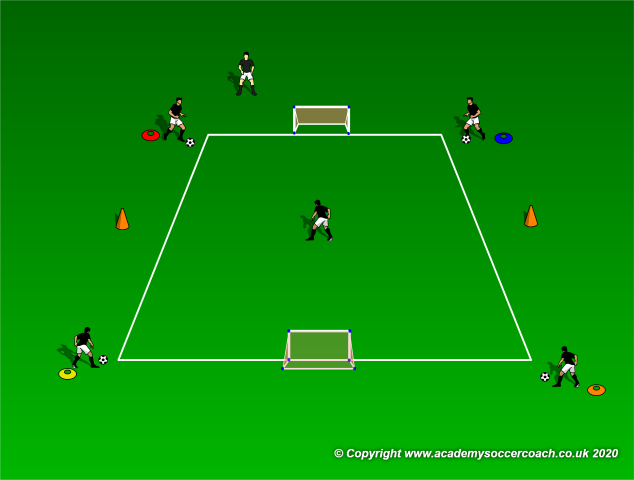
The coach at the top of the diagram shouts or shows a color using a marker.
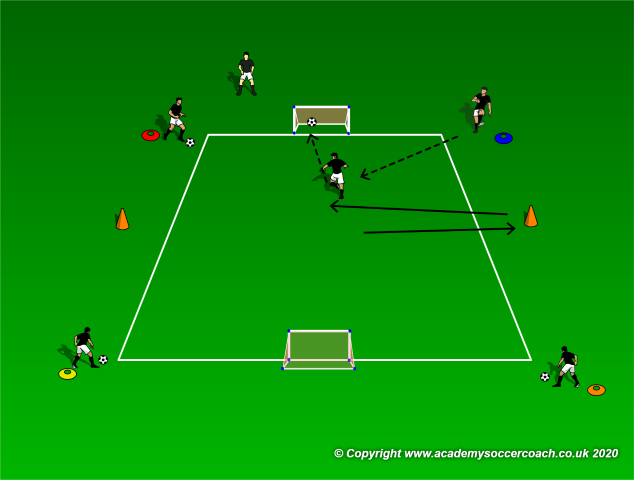
The coach called “blue”, therefore the player in the middle ran to touch the cone that is on the same side as the player on the blue marker. The latter passes the ball to the player in the middle who receives and concludes on the mini goal.
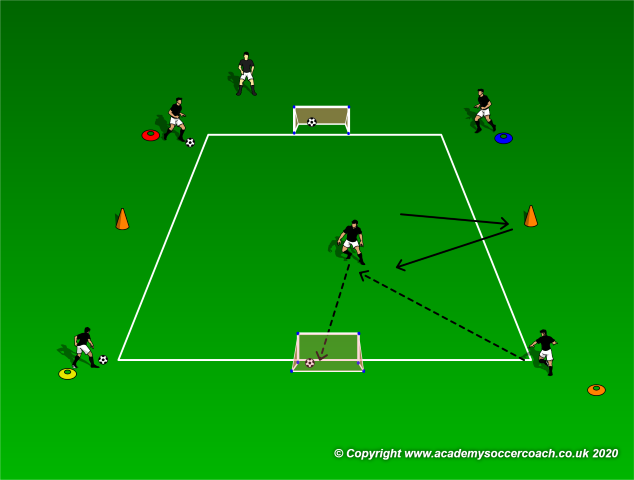
Immediately the coach calls “orange”, the player in the middle again sprints to touch the cone positioned on the same side of the player at the orange corner. The latter passes to the player in the middle who finishes on the mini goal.
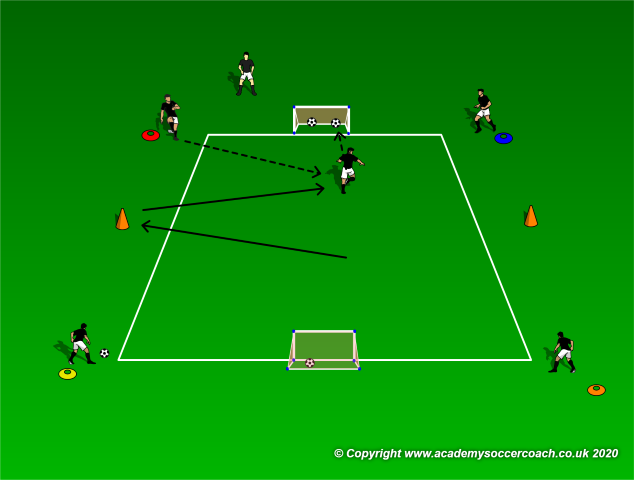
Immediately the coach calls “red” and the player in the middle sprints to touch the cone positioned on the same side as the player at the red corner prior to receiving the ball and finishing on the mini goal.
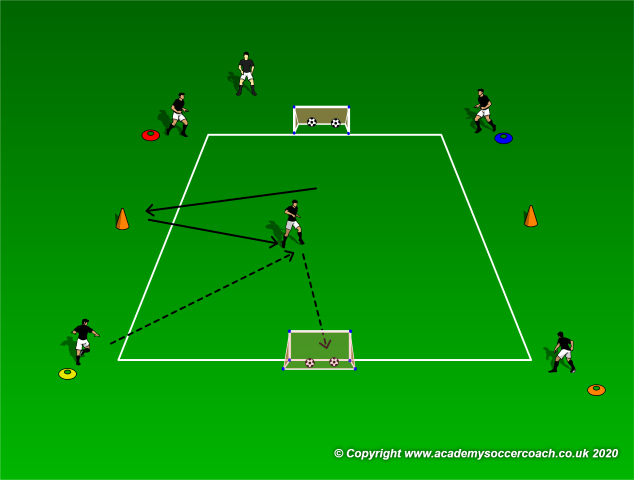
The same as the above sequences is done for the last ball received from the player situated at the yellow corner.
Progressions:
Progression 1 – The player in the middle must conclude at the mini goal with one touch.
Progression 2 – The player in the middle receives tossed balls to head in the mini goals.
6
Progression 3 – The player in the middle must touch the cone opposite the colour called, then turn to receive the ball from the player standing at the called corner (previous image).
Note about the exercise:
Personally I prefer working using visual stimuli as these are the stimuli that the players will have to process the most during the course of a game.
By Philip Cauchi
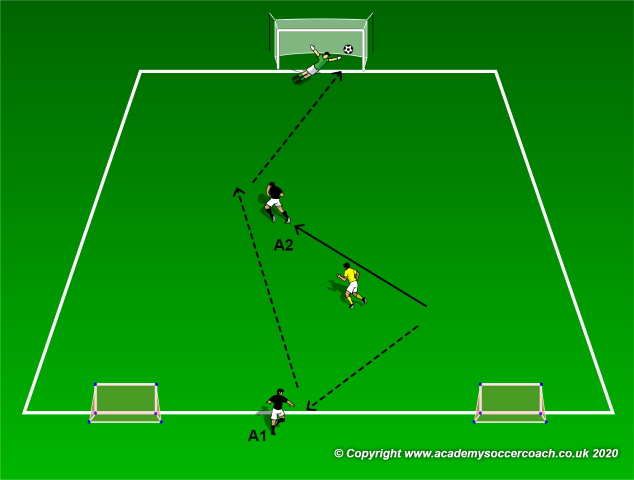
1v1 Conditioning Drills
By Philip Cauchi
Title: Strength in the duel – get unmarked in a 1v1.
Theme: Strength in the duel.
Development of the soccer domains:
Technical: Quality of technical actions performed under heavy opposition pressure such as shielding the ball, passing the ball with accuracy, oriented first touch and shooting.
Tactical: Perform off-the-ball movements such as the counter-movement to get unmarked.
Mental: Play under opposition pressure whilst thinking of various moves to get into an advantageous position to get past the direct opponent.
Physical: Perform quick and rapid explosive movements while holding off the pressure put by the opponent to maintain the body in a state of equilibrium.
Organisation: A regular goal plus a goalkeeper guarding it and two mini goals on the opposite end line. The practice area measures 15 yards by 10 yards. We have a group of attackers and another of defenders. Each group should not have more than four players.
Training load:
Sets: 2.
Repetitions: 6.
Duration each repetition: 12 to 20 seconds.
Recovery between repetitions: 80 seconds (approximate work to rest ratio of 1:4).
Recovery between sets: 3 minutes (light technical activity may be performed during this period thus accelerating the recovery process).
N.B. The training load should be adjusted according to the physical level and maturity of the players. Players should practice in positions and situations they typically experience during a match.
Periodization: The exercise should be carried out immediately after the warm-up when the players are fresh. The session should take place four days before a match (MD-4) and at least seventy two hours past the previous one (MD+3).
Targeted energy system: Anaerobic alactic (produce energy rapidly with minimal lactic acid build-up).
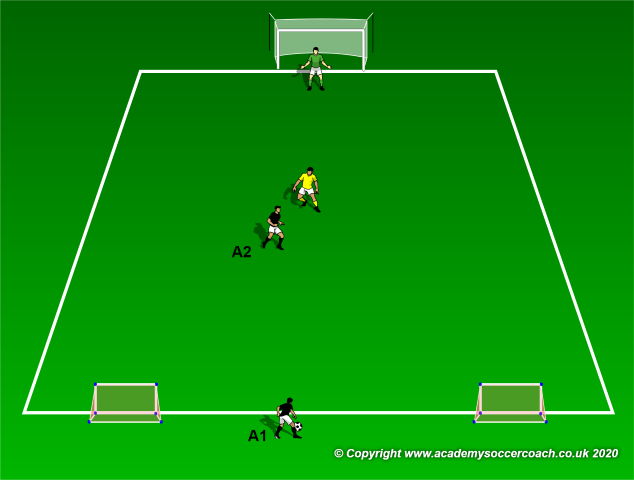
Attacker A1 starts with the ball at his feet. Attacker A2 must perform off-the-ball movements in order to get free from the defender’s marking.
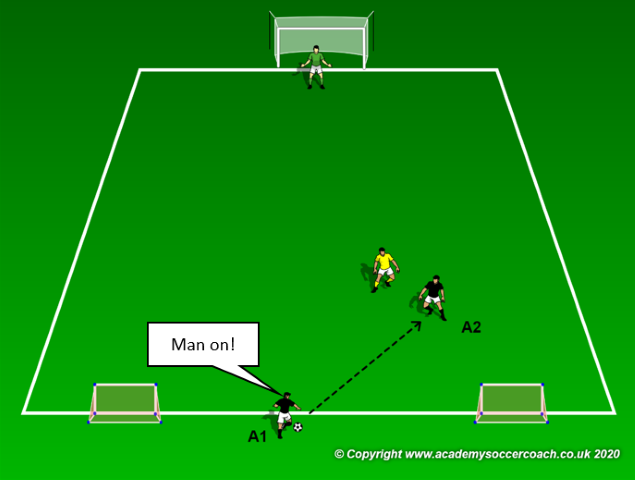
Attacker A1 passes the ball to attacker A2 once the latter gets enough space to receive the ball. Attacker A1 should also coach attacker A2 by calling “man-on” if the defender is putting pressure on him, or “turn” if space is allowed.

The ball may be played back to A1 while A2 attacks the space created behind the defender. After each repetition the three players rotate roles.
Progression.
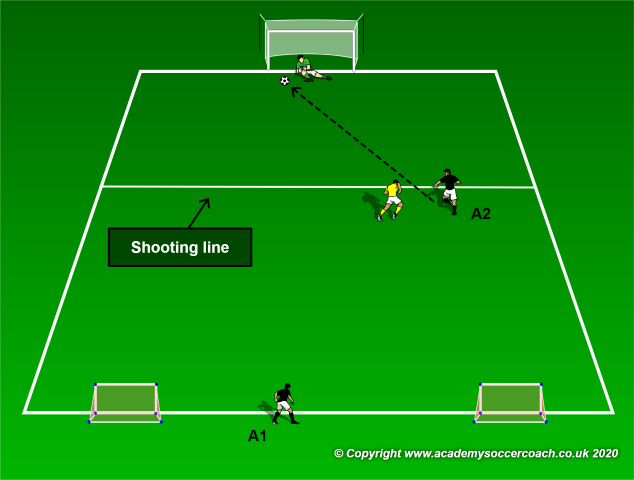
A shooting line can be introduced and which is marked 10 yards from the goal. This leaves an area measuring 10 yards by 10 yards where the 1v1 duel takes place. This is also more challenging for the attacker as he is forced to create the necessary space within a smaller area.
By Philip Cauchi
